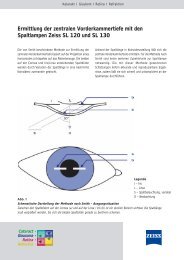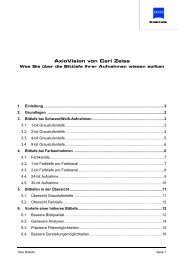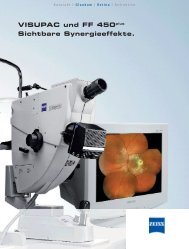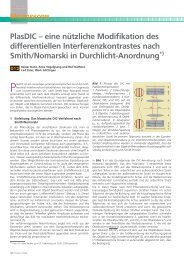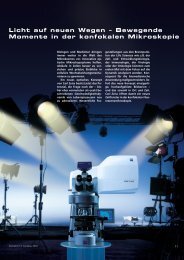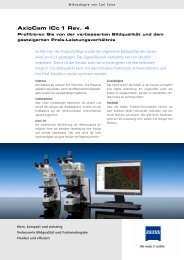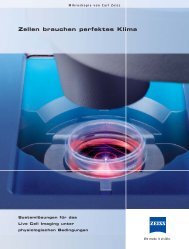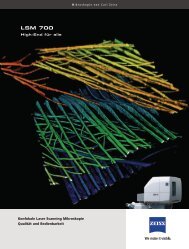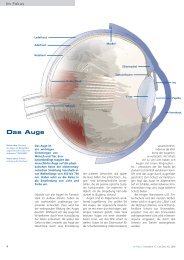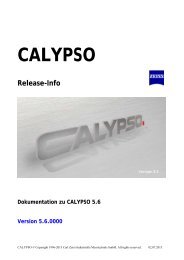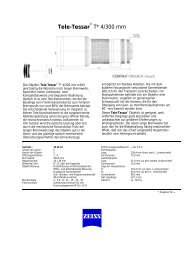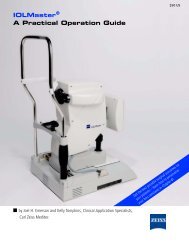Download - Carl Zeiss, Inc.
Download - Carl Zeiss, Inc.
Download - Carl Zeiss, Inc.
Create successful ePaper yourself
Turn your PDF publications into a flip-book with our unique Google optimized e-Paper software.
Imaging<br />
Figure 4: Patient Reports (Print-outs) of Advanced RPE Analysis of Case 3, Presenting Data of the Left Eye<br />
(Figure 4A) and the Right Eye Respectively (Figure 4B)<br />
A<br />
B<br />
While, in the left eye, the sub-retinal pigment epithelium (RPE) slab shows a large central region of sub-RPE illumination, indicating that the area of geographic atrophy has already covered<br />
the fovea, in the right eye, penetration of light to the choroid appears in the perifoveal region only, indicating that the area of geographic atrophy does not cover the fovea. RPE elevations<br />
(indicating drusen) are visible in both eyes in varying amounts.<br />
deformations must be associated with pigmentary changes and thus<br />
will not appear on fundus photographs. Therefore, both methods offer<br />
complementary information and may thus have an important role in<br />
assessing drusen in patients with AMD. 22<br />
So far, a limitation of the new analysis tool might be that only lesions<br />
fitting within the 5 mm circle centred around the fovea can be<br />
measured and evaluated. However, this might be resolved with new<br />
algorithms that are capable of assembling multiple overlapping<br />
SD-OCT images, so that any area can be measured.<br />
Conclusion<br />
Today, SD-OCT allows for high-speed, high-resolution imaging of<br />
retinal structures and provides non-invasive three-dimensional<br />
information on retinal pathology in situ and in real time. It thus leads<br />
to a more profound understanding of a patient’s RPE status, which<br />
is a relevant structure in all forms of AMD. Within the new Advanced<br />
RPE analysis software, SD-OCT technology is combined with robust<br />
algorithms that allow for automated, quantitative assessment of<br />
drusen and atrophic lesions, and could allow for more objective and<br />
easier classification of AMD. As drusen and atrophic lesions can<br />
be evaluated from the same scan pattern, all forms of AMD can be<br />
assessed quantitatively. Furthermore it allows for the detection of<br />
morphologic alterations over time, which should – in conjunction<br />
with functional testing – aid in the stratification of stages of disease<br />
progression. This would be useful for monitoring progression of<br />
disease over time and provides the opportunity to monitor the<br />
effectiveness of new therapies in clinical trials. Of course, in this<br />
context it is of utmost importance to define and evaluate reliable<br />
and reproducible parameters for grading AMD using SD-OCT. As<br />
the new software tool allows for objective and automated<br />
measurements, large patient populations can be monitored easily.<br />
In this respect it is also advantageous that SD-OCT images based<br />
on former Cirrus HD-OCT software can be re-evaluated with the<br />
new analysis tool. Furthermore, it has already been described that<br />
the junctional zone of GA is the site of disease activity and will<br />
be the target for effective therapeutic strategies against dAMD. 23<br />
Here, the new analysis tool could prove useful as it provides<br />
simultaneous measurement of GA along with three-dimensional<br />
visualisation of the RPE and thus can comfortably be used to<br />
gain new insight in microstructural changes underlying disease<br />
progression. The authors’ results with this new analysis tool are<br />
promising, although further studies evaluating reproducibility,<br />
efficacy and feasibility of this new RPE analysis tool are required. n<br />
1. Resnikoff S, Pascolini D, Etya’ale D, et al., Global data on<br />
visual impairment in the year 2002, Bull World Health Organ,<br />
2004;82:844–51.<br />
2. Klein R, Klein BE, Lee KE, et al., Changes in visual acuity in a<br />
population over a 15-year period: the Beaver Dam Eye Study,<br />
Am J Ophthalmol, 2006;142:532–49.<br />
3. Gehrs KM, Anderson DH, Johnson LV, Hageman GS, Agerelated<br />
macular degeneration –emerging pathogenetic and<br />
therapeutic concepts, Ann Med, 2006;38:450–71.<br />
4. Klein R, Chou CF, Klein BE, et al., Prevalence of age-related<br />
macular degeneration in the US population, Arch Ophthalmol,<br />
2011;129:75–80.<br />
5. Friedman DS, O’Colmain BJ, Muñoz B, et al., Eye Diseases<br />
Prevalence Research Group. Prevalence of age-related<br />
macular degeneration in the United States, Arch Ophthalmol,<br />
2004;122:564–72.<br />
6. Age-Related Eye Disease Study Research Group, A<br />
randomized, placebo-controlled, clinical trial of high-dose<br />
supplementation with vitamins C and E, beta carotene, and<br />
zinc for age-related macular degeneration and vision loss:<br />
AREDS report no. 8, Arch Ophthalmol, 2001; 119:1417–36.<br />
7. Augustin AJ, Schmidt-Erfurth U, Kritische worte zur<br />
ARED-Studie, Ophthalmologe, 2002; 99:299–300.<br />
8. Heidrich H, Harnisch JP, Ranft J, PGE1 bei seniler<br />
maculadegeneration. Pilot-Studie, Klin Monatsbl Augenheilkd,<br />
1989;194:282–4.<br />
9. Ladewig MS, Ladewig K, Güner M, Heidrich H, Prostaglandin<br />
E1 infusion therapy in dry age-related macular degeneration,<br />
Prostaglandins Leukot Essent Fatty Acids, 2005;72:251–6.<br />
10. Multicenter Investigation of Rheopheresis for AMD (MIRA-1)<br />
6<br />
EUROPEAN OPHTHALMIC REVIEW



